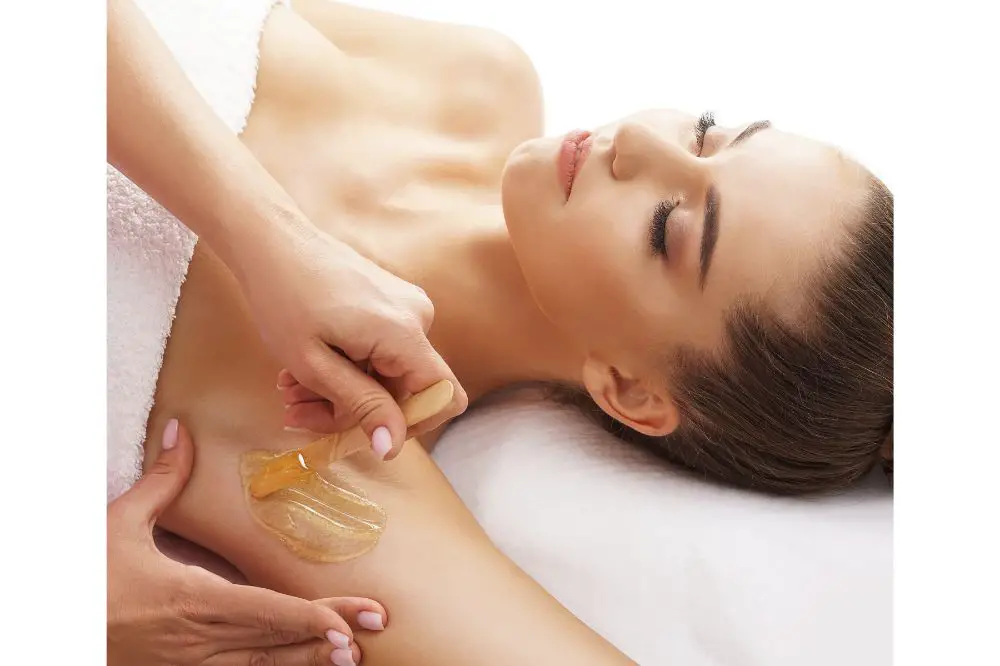Suppose you enjoy having hairless areas on your body but cannot go to the salon. In that case, sugaring is an easy and inexpensive way of removing hair yourself and a wonderful alternative to shaving and waxing strips.
Thousands of years ago, this hair removal method was invented near Ancient Persia and was popular throughout the Middle East and Mediterranean regions. A major appeal of this technique is that its paste is easy to prepare and requires only three ingredients: lemon juice, sugar, and water.
- What Is Hair Removal Using Sugaring?
- Does It Hurt More Than Waxing
- Making the Mixture
- Sugaring at Home: Is It Possible?
- How to Apply the Sugaring Paste to the Skin
- What Are the Benefits of Body Hair Removal With Sugaring?
- Is There a Risk or Side Effect Associated With This Treatment?
- Is the Result Going to Last for a Long Time?
- Conclusion
What Is Hair Removal Using Sugaring?
There are many methods of removing hair. Much like the seasons, everyone possesses a favorite. However, there is no ideal technique for eliminating unwanted hair. The shaving process does not last nearly long enough, some depilatory creams work better than others, and waxing is painful. However, if any approach can come close to an ideal method of removing hair, sugaring may be the solution.
A traditionally used process to remove hair, sugaring eliminates hair from its roots using a natural paste. As opposed to waxing, there’s no need to use strips or cloths to eliminate it, and some other options for removing hair even encourage it. In sugaring, you remove the root of the hair, resulting in less blood supply to the follicle and over time, weakening it. The hair will grow less with each application, and sparser and finer hair will grow. After the procedure, you will have hairless and smooth skin, lasting between four and six weeks.
Does It Hurt More Than Waxing
First things first: Sugaring isn’t painful. Unlike waxing or tweezing, sugaring only adheres to dead skin cells and hair, so the process is less irritating. It is still somewhat painful when sugaring because the roots pull hair out. It’s very mild with no irritation. Due to the thinning and damage caused to the hair follicle by sugaring, the pain will gradually diminish.
In light of that, it’s recommended that sugaring only be performed on longer hair to avoid pain; a quarter-inch of hair growth is required. However, if it is too long, it may be difficult to mold, although experts have mastered the molding technique in small sections to minimize pain. It’s important to remember to always start with clean skin and make sure the paste is firm. As the paste becomes softer, it becomes less painful and harder to work with.
Making the Mixture
Here is a recipe for easy-to-make DIY sugar wax that you can make yourself. Most of the items you’ll need are already in your house:
- 1 portion of water
- 1 portion of lemon juice
- 2 portions of sugar
- A pan for cooking
- Stirring utensil
Instructions:
- Stir constantly while you bring all the ingredients to a boil in a saucepan.
- When the mixture begins to bubble, turn off the burner and stir for a couple of minutes until the bubbles subside. Then put the heat back on and bring it back to a boil.
- The process should be repeated until the mixture is thick and honey-colored.
- The paste can be revived by adding some lemon juice if it has become stiff and crumbly.
- For a test to see if the sugaring paste is too thin, scoop out a spoonful and immerse it in cold water. Allow the mixture to simmer for a while longer if the test piece dissolves in the cold water.
- As soon as the mixture achieves the desired texture, turn off the heat and set it aside until it reaches room temperature.
Sugaring at Home: Is It Possible?
Professionals should handle the process of sugaring. Using a professional to avoid any problems or danger is always advisable. You will need time to master the paste, which may turn into hard toffee. Moreover, if you’re not experienced, the process can be chaotic.
How to Apply the Sugaring Paste to the Skin
Step 1.
Preparation for sugaring isn’t complicated. However, you need at least 1/8 inch of hair to get the best results. After you have the right hair length, wash and dry your skin thoroughly.
Step 2.
If you’re using a ready-made sugaring paste, you need to scoop out some sugar with your fingertips. It will be warm enough thanks to your body heat. Create a small ball by swirling it around your fingers using your thumb.
Step 3.
The sugar should be molded. Take a small section of the skin at a time, and apply the sugar ball on the skin against the direction the hair grows. Gently pat the sugar paste against the skin so that the paste feels completely molded to the skin.
Step 4.
Once you have applied the mixture to the skin with your fingertips, lift and flick the sugar wax in the direction of hair growth and in a parallel manner with your skin. You’ll need to practice this; if it doesn’t go smoothly, take a cloth strip and rub it against the sugar to make it easier to remove.
If you still have sugar on your skin or want to stop completely, break it down gently with warm water. Unlike wax, sugar paste dissolves in water.

What Are the Benefits of Body Hair Removal With Sugaring?
The benefits of sugaring go beyond softer and hairless skin.
As a first step, sugaring exfoliates the skin lightly. Upon application, dead skin cells adhere to the paste, which is removed with the hair to reveal a softer texture. As a result of this exfoliation, the skin looks more youthful.
In the same way as waxing, sugaring will lead to softer, thinner hair growing back over time. Sugaring is a safer, natural hair remover when compared to laser hair removal. Due to how the hair is removed, it’s suitable for all hair types, even curly hair. For those with some sugar left over, you can create a sugar scrub to use in between treatments to keep your skin hydrated and exfoliated. The good thing about sugar wax hair removal is you can use it on any of the places you would normally wax, such as legs, bikini, and underarms.
Is There a Risk or Side Effect Associated With This Treatment?
The area where you have been sugaring may appear red, irritated, or itchy for a short period following the procedure. Symptoms like these are fairly common but try not to scratch them; the skin may be torn or scarred as a result of this. In the case of sensitive skin, the paste may also result in redness and rashes. However, sugaring is generally associated with less discomfort than waxing. Always use fresh lemon juice and organic sugar if possible.
Is the Result Going to Last for a Long Time?
The speed and thickness of your hair growth determine how long it takes to grow back. It takes about three weeks for sugaring to take effect after your first appointment.
Keep up with your hair removal process sessions and you should notice less pain and slower hair growth over time.
Without a regular sugaring process appointment, your growth cycle is disrupted, and you will have to start over. The removal may be more painful if you have to start over. Always test on a small skin patch, especially if you have sensitive skin.
Conclusion
Forget traditional waxing. Sugar waxing is less abrasive than waxing and a good option for at-home hair removal, even though it’s not 100% foolproof. If you don’t want the hassle of making the sugar paste, you can opt for a store brought paste.
How good does it feel knowing you’re applying natural ingredients to your skin rather than other forms of potentially toxic hair removal? If you have a skin disease, be sure to speak to your doctor before applying the sugar paste, as it can cause more irritation. In terms of aftercare, always follow with an organic moisturizer.
Alternatively, if you have difficulty figuring out how to flick your hair for this type of hair removal, it’s best to have a professional do it for you. Rather than putting all the effort into it, save yourself the trouble.

